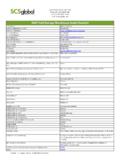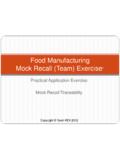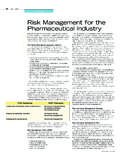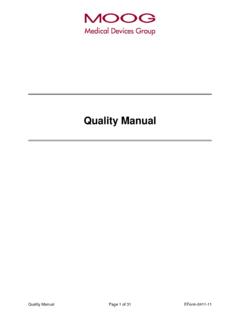Transcription of guide to master formulae final 2012 - WHO
1 guide to master formulae WHO/FWC/IVB/QSS/VQR. 2011. guide to master formulae Guidance Document This guidance document guide TO master formulae is one of a series developed by WHO/FWC/IVB Quality, Safety & Standards team upon request from the manufacturers' members of the Developing Countries Vaccine Manufacturers Network (DCVMN), with funds of USAID. A set of priority topics have been identified by the manufacturers for WHO to provide guidance on expectations from the vaccine prequalification programme. The guidance document guide TO master formulae is targeted primarily at manufacturers who are new to the prequalification of vaccines and who require detailed guidance about the level of detail needed for the development of batch production records. It may also be a useful guide to National Regulatory Authorities (NRAs) in vaccine producing countries.
2 These are not official WHO documents but rather notes for guidance on expected standards to be followed for the prequalification of vaccines. They are based on WHO. recommended requirements but providing further explanations with examples on how these can be actually implemented. 1. guide to master formulae Guidance Document guide TO master formulae . Table of Contents: Page 1) Introduction 4. 2) Terms for master Formula (MF) 4. 3) Definitions of Batch / Lot 5. 4) master formulae needed 5. 5) GMP guidelines on master documentation 5. 6) Required Contents of a MF 6. 7) MF and corresponding Batch Records 11. 8) Formats for MF 11. 9) Issuing of MF copy as a blank batch record 12. 10) Electronic MF and Batch Records 13. 11) Batch Records versus master Formula 14. 12) Batch record review checklist 14. Appendix 1: Extract from: World Health Organization, Technical Report Series, No.
3 908, 2003; Annex 4: good manufacturing Practices for pharmaceutical products: main principles. Appendix 2: Extract from: EUDRALEX; Volume 4 - Medicinal Products for Human and Veterinary Use: good manufacturing Practice: Chapter 4. Documentation. Appendix 3: Extract from: Pharmaceutical Inspection Convention Co-operation Scheme PE 009-3, 1 January 2006; guide to good manufacturing Practice for Medicinal Products; Documentation. Appendix 4: Extract from Canadian GMP Guidelines, Health Canada, Health Products and Food Branch Inspectorate. good manufacturing Practices Guidelines, 2002 Edition, Version 2. 2. guide to master formulae Guidance Document Appendix 5: Extracts from US Code of Federal Regulations (CFR) and US FDA. Guidelines. App 5-1) US Regulations for master Production Records for Finished Pharmaceuticals. Extract from: CFR 21, Chapter I, Subchapter F: Biologics, Part 211 Current good manufacturing Practice for Finished Pharmaceuticals; Subpart F--Production and Process Controls, Sec.
4 Written procedures; deviations; and Subpart J--Records and Reports;. Sec. master production and control records. App 5-2) US Regulations for Batch Records for Finished Pharmaceuticals: Extract from: CFR 21, Chapter I, Subchapter F: Biologics; Subchapter C: Drugs General; Part 211. Current good manufacturing Practice for Finished Pharmaceuticals; Subpart J-- Records and Reports; Sec. Batch production and control records. App 5-3) US Regulations for Batch Records for Biological Products: Extract from: CFR 21, Chapter I, Subchapter F: Biologics, Part 600 Biological Products: General;. subpart B Establishment Standards, Sec Records App 5-4) US FDA Guidelines for Batch Records for Sterile Products: Extract from: Guidance for Industry. Sterile Drug Products Produced by Aseptic Processing . Current good manufacturing Practice. Department of Health and Human Services, Food and Drug Administration, Center for Drug Evaluation and Research (CDER); Center for Biologics Evaluation and Research (CBER); Office of Regulatory Affairs (ORA).
5 September 2004 (Pharmaceutical cGMPs). Appendix 6: Sample master formula for a hypothetical biological product Appendix 7: Example one of a master Formula Appendix 8: Example two of a master Formula Appendix 9: Example three of a master Formula 3. guide to master formulae Guidance Document 1) Introduction In the 1997 WHO guidance document: WHO/ : (A WHO guide to good manufacturing practice (GMP) requirements. Part 1: Standard operating procedures and master formulae ) some basic explanations and instructions were given for preparing various documents required by good manufacturing Practice guidelines from WHO and from several regulatory authorities. GMP guidelines include the requirements for documents (individual), documentation (the systems and formats for documents), and documenting (recording) of production and control activities.
6 Most GMP guidelines provide the same or very similar information as the principles of good manufacturing Practice are now international in scope. In this guidance document, the requirement for master manufacturing instructions and the requirements as given in different GMP documents, different names for these documents and various forms that they can take will be described. This is to guide vaccine manufacturers who are applying for prequalification or re-qualification of their product(s). in the preparation or improvement of current documents for manufacturing operations. 2) Terms for master Formula (MF). WHO identifies manufacturing instructions as master Formula. Other terms used in GMP guidelines and regulations are manufacturing Formula , master Production and Control Record , but all mean the same thing an approved master document that describes the full process of manufacturing for the batch of product with at least cross- reference to the support operations for a batch of a specific product.
7 Individual companies may give internal names to these documents ( manufacturing instructions, monographs, etc). In this guidance document the WHO term master Formula (or MF). will be used. The following are the extracted definitions from several guidelines: WHO GMP Guidelines: A formally authorized master formula should exist for each product and batch size to be manufactured. EU and PIC GMP guidelines: Formally authorised manufacturing Formula and Processing Instructions should exist for each product and batch size to be manufactured. They are often combined in one document.. Health Canada GMP guidelines. master FORMULA (formule-type) - A. document or set of documents specifying the raw materials with their quantities and the packaging materials, together with a detailed description of the procedures and precautions required to produce a specified quantity of a finished product as well as the processing instructions, including the in-process controls.
8 US CFR. To assure uniformity from batch to batch, master production and control records for each drug product, including each batch size thereof, shall be prepared, dated, and signed (full signature, handwritten) by one person and independently checked, dated, and signed by a second person. The preparation of 4. guide to master formulae Guidance Document master production and control records shall be described in a written procedure and such written procedure shall be followed. 3) Definitions of Batch / Lot: A master Formula is required for each batch and batch size. A batch or lot as defined in the WHO GMP guideline (TRS 908 Annex 4) is . batch (or lot). A defined quantity of starting material, packaging material, or product processed in a single process or series of processes so that it is expected to be homogeneous. It may sometimes be necessary to divide a batch into a number of sub-batches, which are later brought together to form a final homogeneous batch.
9 In the case of terminal sterilization, the batch size is determined by the capacity of the autoclave. In continuous manufacture, the batch must correspond to a defined fraction of the production, characterized by its intended homogeneity. The batch size can be defined either as a fixed quantity or as the amount produced in a fixed time interval . In general, the term batch more often refers to intermediates or final formulated bulks which are in one or a few large containers, while lot usually refers to the final product in the final container. They are, however, interchangeable as indicated in WHO's GMP. guideline glossary. 4) master formulae needed: As above, batch or lot will refer to all production intermediates, final formulated bulks and final vialed product. Each master cell bank, viral seed lot, bulk concentrate or viral harvest if stored and tested before release for further processing is a batch and a master formula for its production is written and approved.
10 Also, for different scales of production of any batch or lot, a distinct master formula is prepared. For final container product, as explained in the WHO definition above, a final lot will be the product that is filled during the same continuous fill-run, and in the case of freeze- dried products, the filled vials lyophilized in the same lyophilizer at the same time. These should have unique numbers to identify them as having been processed exactly the same way at the same time. On occasion, when only a part of a large final bulk is filled, the lot numbers for these bulks may have a common identifier with a suffix ( -1 or a ) to show the separate fills. Similarly, a large fill lot with a unique lot number may be lyophilized in different lyophilizers and the suffix would indicate the different freeze- dryer. A master formula for a batch/lot of product with the possibility to select one of several approved equipment items ( a freeze dryer) should clearly indicate this choice and provide space for the unique lot number designation.
















